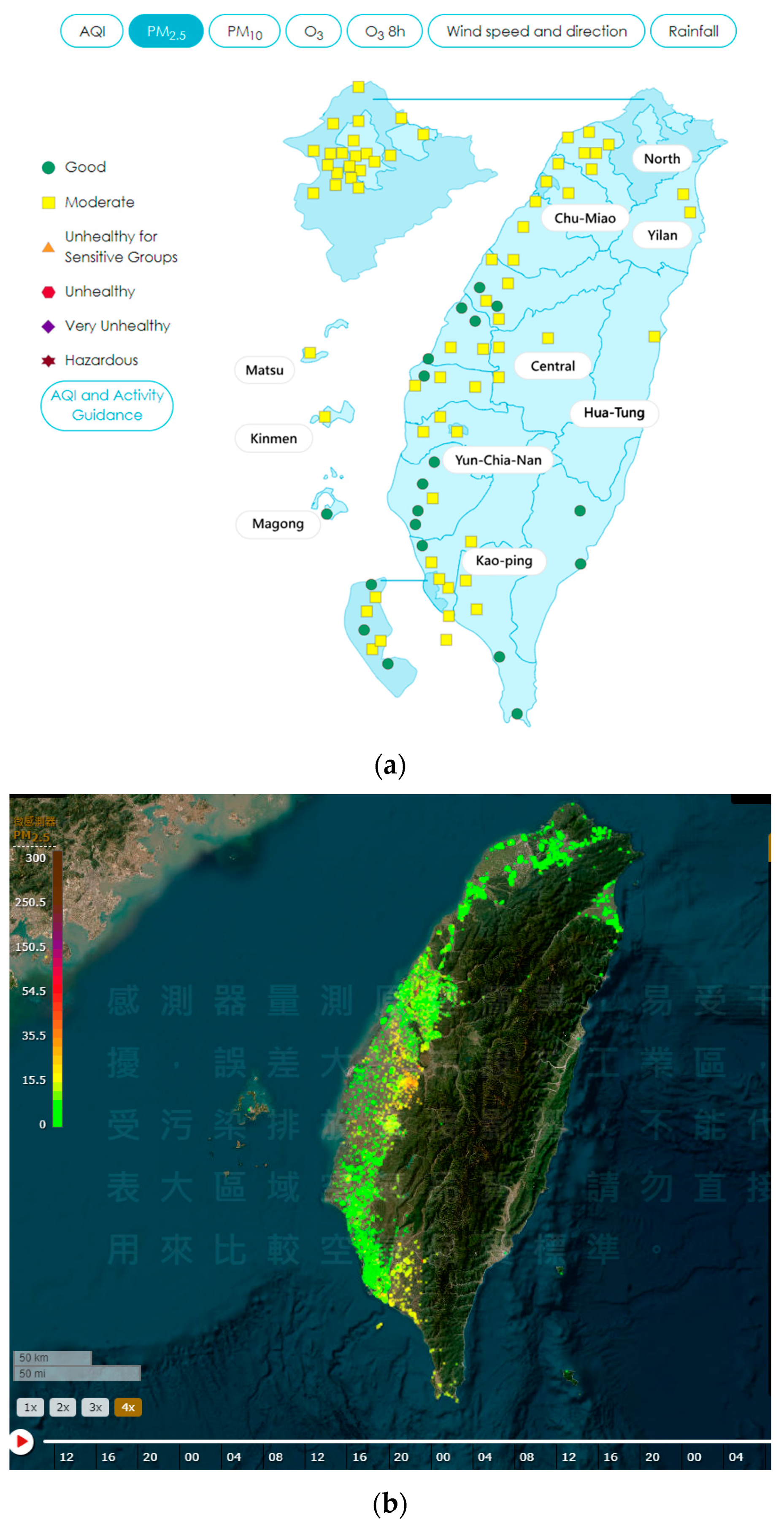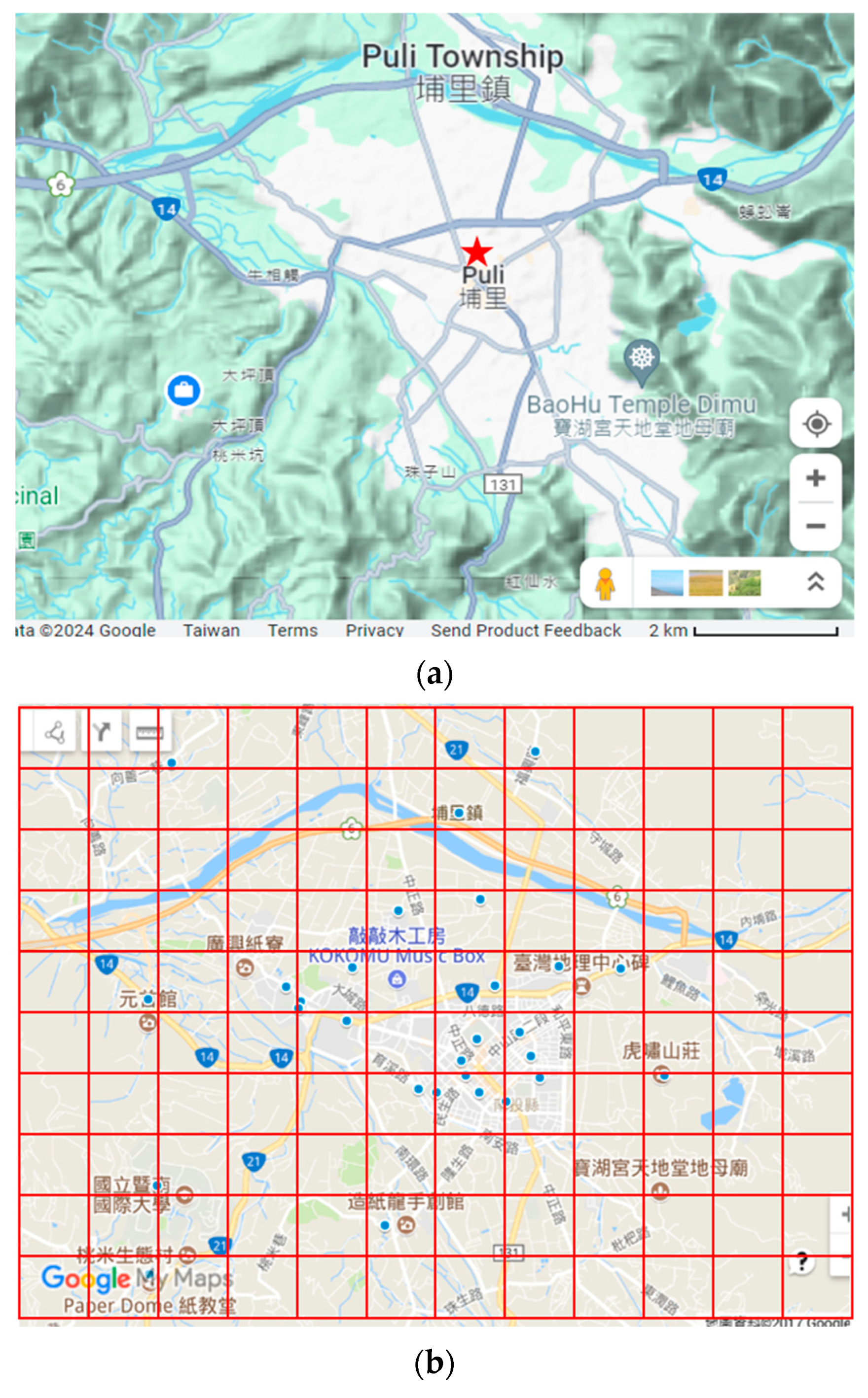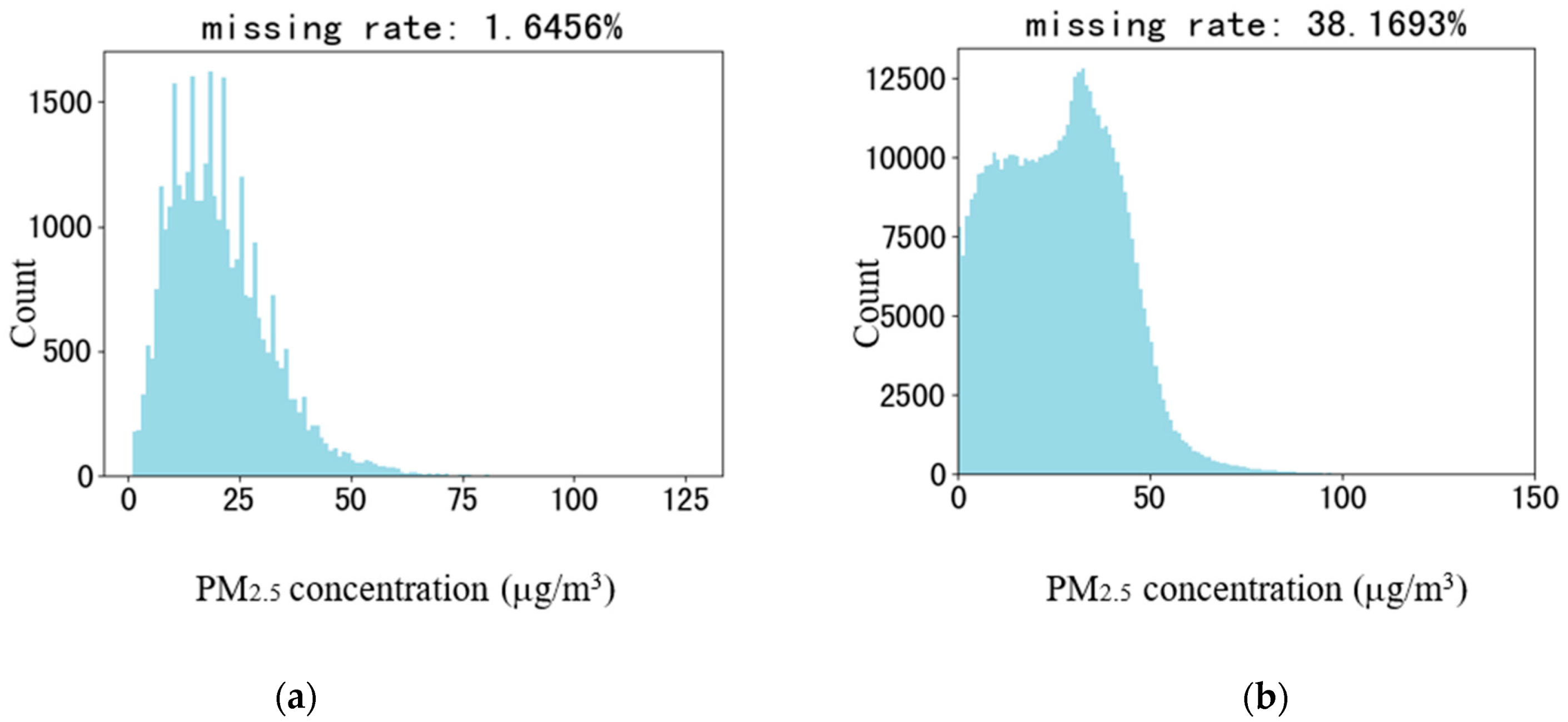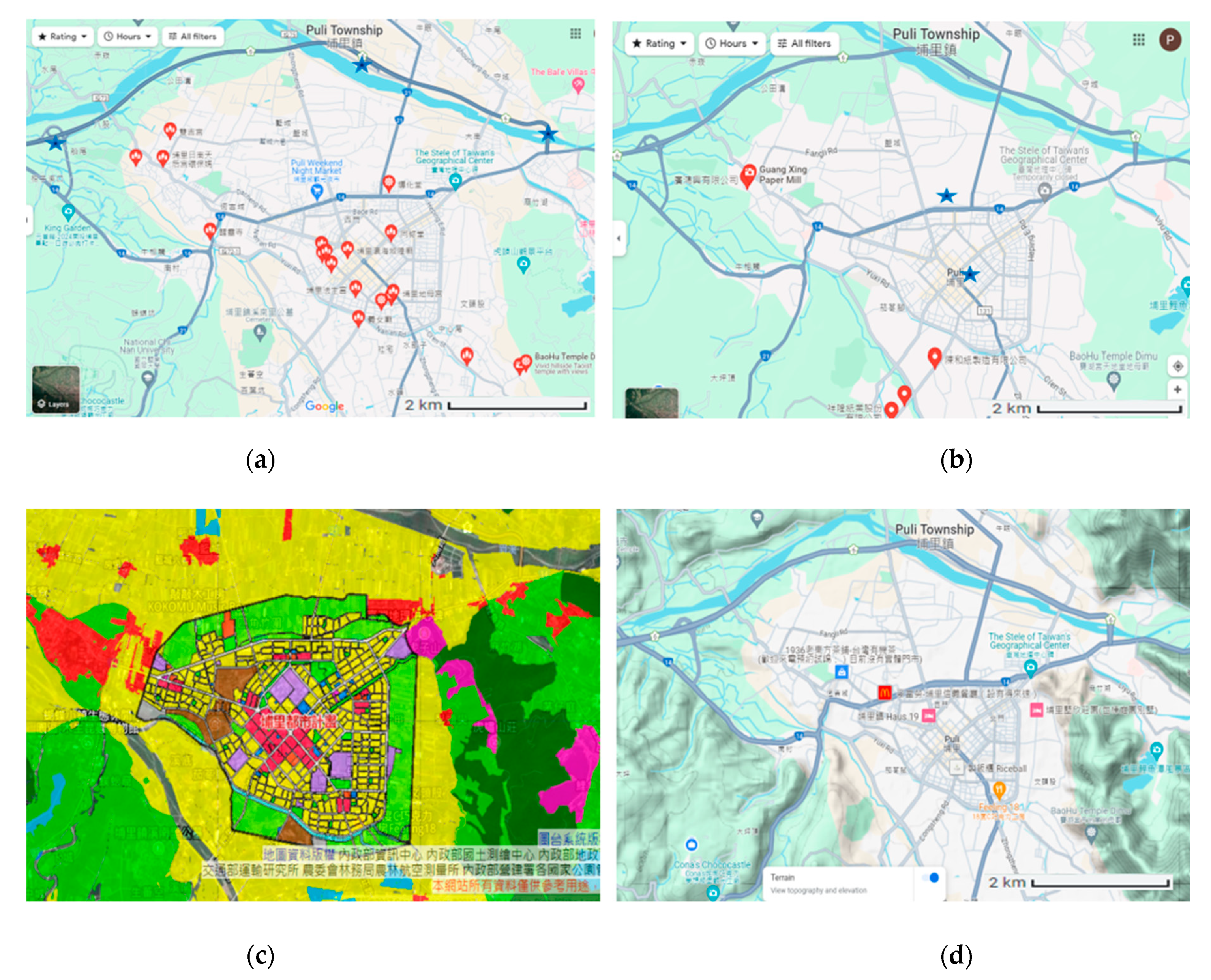Mining Associations between Air Quality and Natural and Anthropogenic Factors
Abstract
:1. Introduction
1.1. Natural and Anthropogenic Factors Affecting Air Quality
1.2. PM2.5 Supersites and Microsites
1.3. Association Rule Mining
1.4. Research Problem, Contributions and Limitations
- As the potential factors vary in spatial scales of air quality-influencing areas, we propose a two-scale analysis framework which includes PM2.5 data from both the Puli supersite and microsites as air-quality indications in terms of coarse and fine resolutions, as a contrast to the single-scale approach adopted by most existing literature.
- To the best of our knowledge, our paper is the first work proposing an association rule mining approach for disclosing the relationship between PM2.5 concentrations and natural and anthropogenic factors. The most relevant literature focused on finding association rules between PM2.5 and PM10 [39] or PM2.5 and diseases [40]. Our research further extends the application reign of using association rule mining in air-quality research.
- The mining task is conducted from the perspective of both macro and micro points of view. The macro-scale association mining aims at gauging the influence on supersite reading variations from wider-area global factors such as meteorological conditions and nation-wide festivals. The micro-scale, on the other hand, infers the association between microsite-tallied PM2.5 concentrations and local landmarks and land uses, where the ancillary activities have impacts on air quality within a smaller area.
- Association rule mining enables us to conduct an exploratory research which broadly explores a large pool of potential factors with minimal human efforts. The mining process automatically scans the cross-sectional data and digs out the significant rules. These rules provide valuable insights for the government to design air-quality control policies and urban development plans. As the microsites are located near citizens’ households, our micro-scale analyses identify the most influential anthropogenic activities in the community. The findings encourage the citizens to take actions against the pollution and increase their willingness to join the deployment of participatory microsites, which further improve the density and applicability of the microsites in the future.
2. Proposed Methods
2.1. Data Collection
2.2. Data Processing
2.3. Association Rule Mining
3. Results
3.1. Macro-Level Pollution Episodes at Supersites
3.1.1. Associations between Air Quality and Meteorological Indicators
3.1.2. Associations between Air Quality and Festivals
3.2. Micro-Level Pollution Episodes at Microsites
3.2.1. Associations between Local Air Quality and Landmarks
3.2.2. Associations between Local Air Quality and Land Uses
4. Conclusions
Funding
Institutional Review Board Statement
Informed Consent Statement
Data Availability Statement
Acknowledgments
Conflicts of Interest
References
- United Nations. Consensus Reached on New Sustainable Development Agenda to Be Adopted by World Leaders in September, 2015. Available online: https://www.un.org/sustainabledevelopment/blog/2015/08/ (accessed on 17 April 2024).
- IPCC. Climate Change 2007: The Scientific Basis, Contribution of Working Group I to the Third Assessment Report of the Intergovernmental Panel on Climate Change; Houghton, J.T., Ding, Y., Griggs, D.J., Noguer, M., Vander Linden, P.J., Dai, X., Maskell, K., Johnson, C.A., Eds.; Cambridge University: New York, NY, USA, 2007. [Google Scholar]
- Liu, Y.-J.; Zhang, T.-T.; Liu, Q.-Y.; Zhang, R.-J.; Sun, Z.-Q.; Zhang, M.-G. Seasonal Variation of Physical and Chemical Properties in TSP, PM10 and PM2.5 at a Roadside Site in Beijing and Their Influence on Atmospheric Visibility. Aerosol Air Qual. Res. 2014, 14, 954–969. [Google Scholar] [CrossRef]
- Mo, L.; Ma, Z.; Xu, Y.; Sun, F.; Lun, X.; Liu, X.; Chen, J.; Yu, X. Assessing the Capacity of Plant Species to Accumulate Particulate Matter in Beijing, China. PLoS ONE 2015, 10, e0140664. [Google Scholar] [CrossRef]
- Song, C.; He, J.; Wu, L.; Jin, T.; Chen, X.; Li, R.; Ren, P.; Zhang, L.; Mao, H. Health burden attributable to ambient PM2.5 in China. Environ. Pollut. 2017, 223, 575–586. [Google Scholar] [CrossRef] [PubMed]
- Kumar, M.; Singh, R.; Banerjee, T. Associating airborne particulates and human health: Exploring possibilities. Environ. Int. 2015, 84, 201–202. [Google Scholar] [CrossRef] [PubMed]
- Banerjee, T.; Singh, N. Book review: Air pollution and health effects. Curr. Sci. 2016, 110, 1108. [Google Scholar]
- Chen, Y.-C.; Chiang, H.-C.; Hsu, C.-Y.; Yang, T.-T.; Lin, T.-Y.; Chen, M.-J.; Chen, N.-T.; Wu, Y.-S. Ambient PM2.5-bound polycyclic aromatic hydrocarbons (PAHs) in Changhua County, central Taiwan: Seasonal variation, source apportionment and cancer risk assessment. Environ. Pollut. 2016, 218, 372–382. [Google Scholar] [CrossRef] [PubMed]
- Han, X.; Liu, Y.; Gao, H.; Ma, J.; Mao, X.; Wang, Y.; Ma, X. Forecasting PM2.5 induced mail lung cancer morbidity in China using satellite retrieved PM2.5 and spatial analysis. Sci. Total Environ. 2017, 607–608, 1009–1017. [Google Scholar] [CrossRef] [PubMed]
- WHO, Ambient (Outdoor) Air Pollution. 2022. Available online: https://www.who.int/en/news-room/fact-sheets/detail/ambient-(outdoor)-air-quality-and-health (accessed on 30 October 2017).
- Hsu, C.-H.; Cheng, F.-Y. Classification of weather patterns to study the influence of meteorological characteristics on PM2.5 concentrations in Yunlin County, Taiwan. Atmos. Environ. 2016, 144, 397–408. [Google Scholar] [CrossRef]
- Wang, J.; Han, J.; Li, T.; Wu, T.; Fang, C. Impact analysis of meteorological variables on PM2.5 pollution in the most polluted cities in China. Heliyon 2023, 9, e17609. [Google Scholar] [CrossRef]
- Dhyani, R.; Sharma, N.; Maity, A.K. Prediction of PM2.5 along urban highway corridor under mixed traffic conditions using CALINE4 model. J. Environ. Manag. 2017, 198, 24–32. [Google Scholar] [CrossRef]
- Lee, W.C.; Shen, L.; Catalano, P.J.; Mickley, L.J.; Koutrakis, P. Effect of future temperature change on PM2.5 infiltration in the greater Boston area. Atmos. Environ. 2017, 150, 98–105. [Google Scholar] [CrossRef]
- Yin, Q.; Wang, J.; Hu, M.; Wong, H. Estimation of daily PM2.5 concentration and its relationship with meteorological conditions in Beijing. J. Environ. Sci. 2016, 48, 161–168. [Google Scholar] [CrossRef] [PubMed]
- Ausati, S.; Amanollahi, J. Assessing the accuracy of ANFIS, EEMD-GRNN, PCR, and MLR models in predicting PM2.5. Atmospheric Environ. 2016, 142, 465–474. [Google Scholar] [CrossRef]
- Niska, H.; Hiltunen, T.; Karppinen, A.; Kolehmainen, M. Evolutionary design and evaluation of modeling system for forecasting urban airborne maximum pollutant concentrations. In Adaptive and Natural Computing Algorithms; Ribeiro, B., Albrecht, R.F., Dobnikar, A., Pearson, D.W., Steele, N.C., Eds.; Springer: Berlin/Heidelberg, Germany, 2005; pp. 181–188. [Google Scholar]
- Tsai, Y.I.; Sopajaree, K.; Kuo, S.-C.; Yu, S.-P. Potential PM2.5 impacts of festival-related burning and other inputs on air quality in an urban area of southern Taiwan. Sci. Total. Environ. 2015, 527-528, 65–79. [Google Scholar] [CrossRef] [PubMed]
- Chen, L.-J.; Ho, Y.-H.; Lee, H.-C.; Wu, H.-C.; Liu, H.-M.; Hsieh, H.-H.; Huang, Y.-T.; Lung, S.-C.C. An Open Framework for Participatory PM2.5 Monitoring in Smart Cities. IEEE Access 2017, 5, 14441–14454. [Google Scholar] [CrossRef]
- Yousefi, R.; Shaheen, A.; Wang, F.; Ge, Q.; Wu, R.; Lelieveld, J.; Wang, J.; Su, X. Fine particulate matter (PM2.5) trends from land surface changes and air pollution policies in China during 1980–2020. J. Environ. Manag. Part B 2023, 326, 116847. [Google Scholar]
- Zhao, L.; Zhang, M.; Cheng, S.; Fang, Y.; Wang, S.; Zhou, C. Investigate the effects of urban land use on PM2.5 concentration: An application of deep learning simulation. J. Affect. Disord. 2023, 242, 110521. [Google Scholar] [CrossRef]
- Di, Q.; Koutrakis, P.; Schwartz, J. A hybrid prediction model for PM2.5 mass and components using a chemical transport model and land use regression. Atmospheric Environ. 2016, 131, 390–399. [Google Scholar] [CrossRef]
- Habermann, M.; Billger, M.; Haeger-Eugensson, M. Land use Regression as Method to Model Air Pollution. Previous Results for Gothenburg/Sweden. Procedia Eng. 2015, 115, 21–28. [Google Scholar] [CrossRef]
- Liu, X.J.; Xia, S.Y.; Yang, Y.; Wu, J.F.; Zhou, Y.N.; Ren, Y.W. Spatiotemporal dynamics and impacts of socioeconomic and natural conditions on PM2.5 in the Yangtze River Economic Belt. Environ. Pollut. 2020, 263, 114569. [Google Scholar] [CrossRef]
- Yang, D.; Chen, Y.; Miao, C.; Liu, D. Spatiotemporal variation of PM2.5 concentrations and its relationship to urbanization in the Yangtze river delta region, China. Atmos. Pollut. Res. 2020, 11, 491–498. [Google Scholar] [CrossRef]
- Liang, C.-S.; Duan, F.-K.; He, K.-B.; Ma, Y.-L. Review on recent progress in observations, source identifications and countermeasures of PM2.5. Environ. Int. 2016, 86, 150–170. [Google Scholar] [CrossRef] [PubMed]
- Singh, N.; Murari, V.; Kumar, M.; Barman, S.; Banerjee, T. Fine particulates over South Asia: Review and meta-analysis of PM2.5 source apportionment through receptor model. Environ. Pollut. 2017, 223, 121–136. [Google Scholar] [CrossRef] [PubMed]
- Yin, P.-Y.; Tsai, C.-C.; Day, R.-F.; Tung, C.-Y.; Bhanu, B. Ensemble learning of model hyperparameters and spatiotemporal data for calibration of low-cost PM2.5 sensors. Math. Biosci. Eng. 2019, 16, 6858–6873. [Google Scholar] [CrossRef] [PubMed]
- Day, R.F.; Yin, P.Y.; Huang, Y.C.T.; Wang, C.Y.; Tsai, C.C.; Yu, C.H. Concentration-temporal multilevel calibration of PM2.5 low-cost sensor. Sustainability 2022, 14, 10015. [Google Scholar] [CrossRef]
- Hu, K.; Rahman, A.; Bhrugubanda, H.; Sivaraman, V. HazeEst: Machine Learning Based Metropolitan Air Pollution Estimation From Fixed and Mobile Sensors. IEEE Sensors J. 2017, 17, 3517–3525. [Google Scholar] [CrossRef]
- Miksys, M. Predictions of PM2.5 and PM10 Concentrations Using Static and Mobile Sensors; Technical Report; School of Informatics, University of Edinburgh: Edinburgh, UK, 2016. [Google Scholar]
- Keyes, T.; Domingo, R.; Dynowski, S.; Graves, R.; Klein, M.; Leonard, M.; Pilgrim, J.; Sanchirico, A.; Trinkaus, K. Low-cost PM2.5 sensors can help identify driving factors of poor air quality and benefit communities. Heliyon 2023, 9, e19876. [Google Scholar] [CrossRef] [PubMed]
- Han, J.; Kamber, M. Data Mining: Concepts and Techniques; Morgan Kaufmann Publishers: San Francisco, CA, USA, 2001. [Google Scholar]
- Diaz-Garcia, J.A.; Ruiz, M.D.; Martin-Bautista, M.J. A survey on the use of association rules mining techniques in textual social media. Artif. Intell. Rev. 2023, 56, 1175–1200. [Google Scholar] [CrossRef] [PubMed]
- Agrawal, R.; Imieliński, T.; Swami, A. Mining association rules between sets of items in large databases. In Proceedings of the ACM-SIGMOD, International Conference on Management of Data, Washington, DC, USA, 26–28 May 1993; pp. 207–216. [Google Scholar]
- Agrawal, R.; Srikant, R. Fast algorithm for mining association rules. Proceedings of Conference on Very Large Data Bases, Santiago, Chile, 12–15 September 1994; pp. 487–499. [Google Scholar]
- Savasere, A.; Omiecinski, E.; Navathe, S. An efficient algorithm for mining association rules in large databases. In Proceedings of the 21st International Conference on Very Large Data-Bases, Zurich, Switzerland, 11–15 September 1995; pp. 432–444. [Google Scholar]
- Pei, J.; Han, J. Can we push more constraints into frequent pattern mining? Proceedings of sixth ACM SIGKDD International Conference on Knowledge Discovery and Data Mining, Boston, MA, USA, 20–23 August 2000; pp. 350–354. [Google Scholar]
- Qin, S.; Liu, F.; Wang, C.; Song, Y.; Qu, J. Spatial-temporal analysis and projection of extreme particulate matter (PM10 and PM2.5) levels using association rules: A case study of the Jing-Jin-Ji region, China. Atmos. Environ. 2015, 120, 339–350. [Google Scholar] [CrossRef]
- Sadat, Y.K.; Karimipour, F.; Sadat, A.K. Investigating the relation between prevalence of asthmatic allergy with the characteristics of the environment using association rule mining. In Proceedings of the 1st ISPRS International Conference on Geospatial Information Research, Tehran, Iran, 15–17 November 2014; pp. 169–174. [Google Scholar]
- Yin, P.-Y. Spatiotemporal retrieval and feature analysis of air pollution episodes. Math. Biosci. Eng. 2023, 20, 16824–16845. [Google Scholar] [CrossRef]
- Nantou County Environmental Protection Bureau (NCEPB), 10 Air-Quality Alert Levels. Available online: https://www.ntepb.gov.tw/eng/news/Details.aspx?Parser=9,15,95,,,,15197,,,,1 (accessed on 15 March 2024).






| TP (Celsius) | RH (%) | WS (m/s) | AP (hPA) | Prec (mm) | |
|---|---|---|---|---|---|
| H | >24.7 | >93 | >0.9 | >964.9 | >1.5 |
| M | 20.8~24.7 | 76~93 | 0.4~0.9 | 960.5~964.9 | 0.1~1.5 |
| L | ≤20.8 | ≤76 | ≤0.4 | ≤960.5 | ≤0.1 |
| Ant. | Con. | Sup(Ant.) | Sup(Con.) | Con.) | Confidence | Lift |
|---|---|---|---|---|---|---|
| RH_M, TP_L | PM2.5_H | 0.1536 | 0.1174 | 0.0382 | 0.2485 | 2.17 |
| RH_M, TP_L, AP_H | PM2.5_H | 0.1154 | 0.1174 | 0.0278 | 0.2412 | 2.05 |
| RH_M, AP_H | PM2.5_H | 0.1387 | 0.1174 | 0.0332 | 0.2394 | 2.04 |
| RH_M, AP_H | PM2.5_3 | 0.1387 | 0.2448 | 0.0498 | 0.3588 | 1.47 |
| WD_W, TP_L, AP_H | PM2.5_3 | 0.1154 | 0.2448 | 0.0411 | 0.3563 | 1.46 |
| RH_M, TP_L | PM2.5_3 | 0.1536 | 0.2448 | 0.0537 | 0.3499 | 1.43 |
| AP_L, TP_H | PM2.5_2 | 0.1835 | 0.4063 | 0.0904 | 0.4927 | 1.21 |
| AP_L, TP_H, WS_H | PM2.5_2 | 0.1074 | 0.4063 | 0.0526 | 0.4899 | 1.21 |
| AP_L, TP_H, RH_M | PM2.5_2 | 0.1105 | 0.4063 | 0.0541 | 0.4898 | 1.21 |
| TP_M, AP_L | PM2.5_1 | 0.1368 | 0.2172 | 0.0701 | 0.5167 | 2.38 |
| RH_H, TP_M | PM2.5_1 | 0.1448 | 0.2172 | 0.0726 | 0.5017 | 2.31 |
| RH_H, AP_L | PM2.5_1 | 0.1182 | 0.2172 | 0.0591 | 0.5002 | 2.30 |
| Prec_L (0.923) | Prec_M (0.043) | Prec_H (0.034) | |
|---|---|---|---|
| PM2.5_H (0.1174) | 0.0873 | 0.0457 | 0.0241 |
| PM2.5_3 (0.2448) | 0.2255 | 0.0844 | 0.0771 |
| PM2.5_2 (0.4063) | 0.4132 | 0.3232 | 0.3314 |
| PM2.5_1 (0.2172) | 0.2740 | 0.5466 | 0.5674 |
| Prec_L (0.923) | Prec_M (0.043) | Prec_H (0.034) | |
|---|---|---|---|
| PM2.5_H (0.1174) | 0.8114 | 0.1306 | 0.0580 |
| PM2.5_3 (0.2448) | 0.7912 | 0.1113 | 0.0975 |
| PM2.5_2 (0.4063) | 0.7412 | 0.1423 | 0.1166 |
| PM2.5_1 (0.2172) | 0.6012 | 0.2191 | 0.1797 |
| PM2.5 Categories | 2017~2019 | All Festivals in 2017~2019 | Lunar New Year Eve (15:00~01:00) | New Year Eve (15:00~01:00) |
|---|---|---|---|---|
| PM2.5_H | 0.1174 | 0.1328 | 0.375 | 0.500 |
| PM2.5_3 | 0.2448 | 0.3683 | 0.375 | 0.250 |
| PM2.5_2 | 0.4063 | 0.3597 | 0.200 | 0.225 |
| PM2.5_1 | 0.2172 | 0.1392 | 0.050 | 0.025 |
| PM2.5 Categories | TSD in 2017~2019 | TSD in 2017 | TSD in 2018 | TSD in 2019 |
|---|---|---|---|---|
| PM2.5_H | 0.264 | 0.458 | 0.333 | 0.0 |
| PM2.5_3 | 0.639 | 0.458 | 0.667 | 0.792 |
| PM2.5_2 | 0.097 | 0.084 | 0.0 | 0.208 |
| PM2.5_1 | 0.0 | 0.0 | 0.0 | 0.0 |
| PM2.5 Category | 2017~2019 | Night Market | Crossroad | Paper Mill | Temple | Highway Exit | Elem. School |
|---|---|---|---|---|---|---|---|
| PM2.5_H | 0.3147 | 0.3866 | 0.3615 | 0.3562 | 0.3347 | 0.3308 | 0.3139 |
| PM2.5_3 | 0.2639 | 0.3217 | 0.2640 | 0.2670 | 0.2632 | 0.2983 | 0.2729 |
| PM2.5_2 | 0.2298 | 0.2196 | 0.2062 | 0.2118 | 0.2213 | 0.2287 | 0.2270 |
| PM2.5_1 | 0.1916 | 0.0721 | 0.1683 | 0.1650 | 0.1808 | 0.1423 | 0.1862 |
| PM2.5 Category | 2017~2019 | Business | Resident | High Land | Agriculture |
|---|---|---|---|---|---|
| PM2.5_H | 0.3147 | 0.4467 | 0.3346 | 0.2975 | 0.2488 |
| PM2.5_3 | 0.2639 | 0.3008 | 0.2582 | 0.2604 | 0.2415 |
| PM2.5_2 | 0.2298 | 0.1684 | 0.2228 | 0.2340 | 0.2731 |
| PM2.5_1 | 0.1916 | 0.0841 | 0.1844 | 0.2080 | 0.2366 |
Disclaimer/Publisher’s Note: The statements, opinions and data contained in all publications are solely those of the individual author(s) and contributor(s) and not of MDPI and/or the editor(s). MDPI and/or the editor(s) disclaim responsibility for any injury to people or property resulting from any ideas, methods, instructions or products referred to in the content. |
© 2024 by the author. Licensee MDPI, Basel, Switzerland. This article is an open access article distributed under the terms and conditions of the Creative Commons Attribution (CC BY) license (https://creativecommons.org/licenses/by/4.0/).
Share and Cite
Yin, P.-Y. Mining Associations between Air Quality and Natural and Anthropogenic Factors. Sustainability 2024, 16, 4614. https://doi.org/10.3390/su16114614
Yin P-Y. Mining Associations between Air Quality and Natural and Anthropogenic Factors. Sustainability. 2024; 16(11):4614. https://doi.org/10.3390/su16114614
Chicago/Turabian StyleYin, Peng-Yeng. 2024. "Mining Associations between Air Quality and Natural and Anthropogenic Factors" Sustainability 16, no. 11: 4614. https://doi.org/10.3390/su16114614






